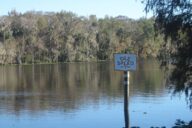Phragmites Australis
Daniel Kelly | Fondriest Environmental
Phragmites australis, thought to have come from Europe, has been found to be native in parts of North America, including the southwestern United States. But in many areas, as well as the Great Lakes region, the common reed is regarded as an unwanted invasive species.
Growing in thick, dense mats, Phragmites australis is found in many coastal regions, as well as along roadways, ditches and other open areas. It is believed to have completely edged out native Phragmites in New England and threatens native reed plants in other parts of North America.
It is difficult to distinguish Phragmites australis from native ones because their appearances are quite similar:
With its robust expansion capabilities, Phragmites australis can spread quite rapidly, taking over areas and achieving dominance in not much time. A warm season grass, Phragmites australis typically grows following the last coming of frost in the spring. Its stems can grow up to an inch and a half per day during optimal growing conditions. And though it may seem that the reed spreads mostly by propagating its seeds, it is more common for P. australis to use a network of underground rootstalks, or rhizomes.
Effects of the plant are far-reaching: its reed stands provide poor nesting habitat for waterfowl and other birds. It tends to out-compete and eliminate other marsh grasses, as well as water plant species. Some less-tangible impacts of Phragmites australis include loss of the view of shoreline habitat, and reduced access for swimming and fishing.
Prevent Its Spread
Simple steps to keeping Phragmites australis from spreading include rinsing plant matter, mud and other debris from outdoor gear after use. Avoid planting the reed in ill-advised efforts to control erosion and do not use P. australis as a livestock crop.
To eradicate it, the key is to begin control efforts as soon after the initial invasion as possible. It is not feasible to remove the plant by manually pulling it out as its root system is too extensive. But effective methods of removal include low-strength herbicides, as well as others that rob the plant of water. A cut-stem method can be used to make herbicide application more potent. It involves cutting the reed at waist height, exposing a hollow portion of stem and then pouring a 50:50 glyphosate and water mix in the opening. Treatment areas exposed to this method typically require repeat applications for years to eradicate the plant completely.
Sources:
- https://www.in.gov/dnr/files/Phragmites.pdf
- http://www.fs.fed.us/database/feis/plants/graminoid/phraus/all.html
- http://www.michigan.gov/deq/0,4561,7-135-3313_8314-178183–,00.html
- https://www.nps.gov/gate/learn/nature/phragmites.htm
- https://www.nps.gov/caco/learn/nature/phragmites-control.htm
- http://www.pnas.org/content/99/4/2445.full.pdf
- http://www.sciencedirect.com/science/article/pii/S0380133012002122
- http://www.fondriest.com/news/satellite-map-of-great-lakes-phragmites-helps-fight-against-invasive-plant.htm










